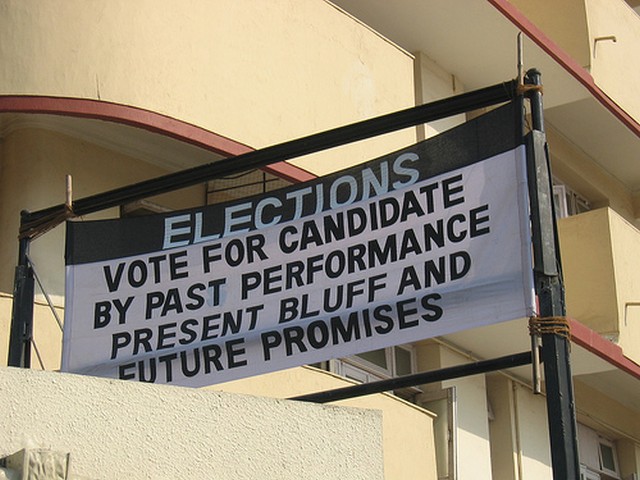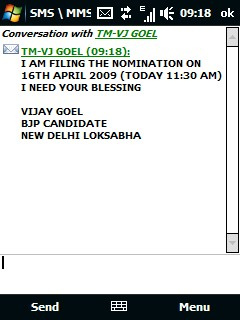 [1]
[1]Election commentary in Marine Drive, Mumbai. Image by Dannybirchall and used under a Creative Commons License
Now that the 15th general elections are underway in India, the big question in every body’s mind is who is going to win? Will one party take it all or will there be no clear winner, which means a coalition government or a political patchwork quilt at the center?
To form the next government, either one party or a coalition of parties must prove they hold a majority in the Lok Sabha [2] (Lower House) of the Indian Parliament. There are 543 seats [3] to the Lok Sabha with thousands of candidates fighting to win the seat from literally over a thousand different political parties. Here is a snapshot of the number of seats in some of the key states. The Northern state of Uttar Pradesh [4] has the largest number of seats: 80. Andhra Pradesh [5] and Bihar [6] are next with 42 and 40 seats, while Tamil Nadu [7] has 39 seats, Gujarat [8] has 26 seats, Orissa [9] has 21 seats and Kerala [10] has 20 seats.
The results of the elections are expected to be announced by May 16th and a new government will be formed by June 2nd, 2009. Prior to the elections it seemed that the race would be between the ruling Congress Party and it coalition and the Bharatiya Janata Party (BJP) that was ousted in the 2004 general elections. However, psephologists, analysts, observers and digital tea readers have been left scratching their heads with some recent developments. Oh, and let us not forget the astrologers.
Prior to the start of the election this was the broad thinking about the outcome: that either the Congress or the BJP will win the elections with support from various regional parties including the Third Front (yes, yes, I know the Third Front, esp the Communist elements have repeatedly said they will not go with Congress or BJP. But, never say never in politics and that is why the phrase politics makes strange bedfellows). The thinking was that the chances of a Third Front victory was a remote possibility with perhaps Mayawati as the candidate for Prime Minister. But, it seems that broad thinking on the election outcome will have to be tweaked. Analysts and various media reports say at this point it is anybody’s guess which party or parties are going to win and form a new coalition government. I guess one thing is certain: it will be a coalition government, but will be the mix of parties is still an unknown element.
Here are some reasons why analysts are revising or hedging their bets on the outcome of this general election in India.
The rise of regional parties: It appears that neither the Congress (and it allies) nor the BJP (and its allies) will win with a clear majority. There are over 1000 parties contesting the general elections in India, and a handful of these regional parties will play a key role in the formation of the next new government in early June. For the past 20 years the trend has been some sort of a coalition government at the center. The interesting trend to note is the the number of coalition partners required to form the government at the center has grown in number (increasing fragmentation) over the years and that clearly underscores the rise and importance of regional political parties.
Since the 1980s there has been a steady proliferation of regional parties in India, and they have come to play a key role at the Federal level. Along with the rise of the regional parties there was also devolvement [11] of power from the center to the state governments. Mrs. Indira Gandhi was perhaps the last Prime Minister of India who wielded an iron fist when it came to center-state relationships. (Note: approx 40-45 percent of India’s current population was born after the brutal assassination of Mrs. Gandhi in 1984)
In the 2004 general elections in India there were no clear winners and the Congress hastily cobbled together an unwieldy coalition of different parties, including the Left party left by comrade Prakash Karat of Communist Party of India (Marxist) CPI (M).
And in this general elections the musical chairs and constantly shifting alliances between various regional parties means that many of the key regional parties are hedging their bets and want to play it by ear. Take the case of Orissa’s Chief Minister Navin Patnaik. According to The Wall Street Journal (WSJ) [12]:
“the Biju Janata Dal, broke off an 11-year partnership with the BJP, contesting the state’s 21 seats on its own for the first time since Mr. Patnaik created the party in 1998…(he) has signaled that while he’s open to other options, he won’t throw his support behind either Congress or the BJP.”
Or, take the case of Andhra Pradesh as WSJ points out, “where the Congress alliance with the local parties collapsed and it went to the polls alone in this Southern State that has 42 seats.”
The 2 states to watch out will be Gujarat and Uttar Pradesh (also Tamil Nadu, Andhra Pradesh and Karnataka) BJP’s Narendra Modi [13] has been Gujarat’s Chief Minister since 2001 and has a fairly stronghold there because of the economic development of the state. BJP’s LK Advani [14] is contesting from Gujarat. Voters generally vote with their pocket book and that just be the case in Gujarat in this election although there could be an erosion in BJP’s influence in the state. For instance, Mallika Sarabhai [15] is running against LK Advani in Gujarat and her campaign style and the issues that is raising is vastly different from Modi/Advani platform. She is targeting the youth and women voters, two important voting blocs in this election.
The second state to watch out for is Uttar Pradesh, which is a battle ground state with all the major and regional parties duking it out. Mayawati [16] of the Bahujan Samaj Party (BSP) made a triumphant return as the Chief Minister of Uttar Pradesh in 2007 by her skillful social and political engineering. Mayawati harbors strong ambitions [17] to become the next Prime Minister of India and has flirted with the newly formed Third Front without having officially joined them.
BSP’s main opposition is Mulayam Singh’s Samajwadi Party [18] that counts Bollywood actors Jaya Bachchan and Sanjay Dutt as its supporters. Singh is part of a loose conglomeration of regional political parties called The Fourth Front [19] that includes the South Indian-actor turned politician Chiranjeevi from Andhra Pradesh. Then there is the Congress Party’s quest to regain the state that is spearheaded by Rahul Gandhi [20]. Uttar Pradesh has been the traditional stomping ground for the Gandhi family starting with Allahabad and then Amethi. And finally there is the BJP, which has a fair degree of hold in the state but all that may have been eroded by the Varun Gandhi episode [21] in Pilibhit.
In both Gujarat and Uttar Pradesh religion and caste play a strong role in the political arena.
 [22]
[22]Political Campaign 2.0 – Image by Flickr user baxiabhishek and used under a Creative Commons License
The rise of independents: In this year’s general elections there is an interesting new trend: the rise of the independent candidates who are fighting the elections. There is Meera Sanyal [23] who is fighting from South Mumbai, Captain CK Gopinath [24] from South Bangalore and Mallika Sarabhai [25] from Gandhinagar in Gujarat. Both Sanyal and Capt Gopinath have a strong business background and are fighting the election on local issues. Sanyal [26] is the head of ABN Amro, while Capt Gopinath [27] was a co-founder of Deccan Airlines, a no-frills aviation company that was acquired by Vijay Mallaya’s [28] Kingfisher. Both candidates are using a combination of old and new media [29] to reach out to their voter base and appear to have succeeded in mobilizing their voter base. It will be interesting to see the outcome for both these elections. The more interesting thing to watch out for is whether more independent candidates will contest the election at a future date. Could it be that middle-class professionals, who have traditionally stayed away from politics might finally step in and start contesting the elections?
Youth and Women Voters: One of the fascinating thing about this general election in India is the various ways in which you slice and dice the numbers. There are over 714 million voters with about 25 percent of them under the age of 35 year. Roughly half the voters are women. The two blocs to watch out for is the youth and women voters. How will they vote? Will they vote based on issues or pocketbook? Do they have enduring party loyalties like some of the older voters might have? How these two groups vote might yield interesting result.
I don’t think many of the political leaders have a crystal clear idea of what might appeal to the younger generation, who grew up in a very different economic, political and social framework. This is a generation that has a strong sense of the culture of information technology. This will perhaps be the first election where the beginnings of what makes the next generation of voters tick emerges. India is one of the youngest countries in the world where 60 percent of the population is under the age of 35 years and they are the ones who are going to shape the future of the country.
There are lots of other variables that could influence the outcome of this general elections in India. Yes, while it seems that there may be no clear winner in this election it is also important to remember that there is almost a month left before the elections conclude. And a lot could happen in a month.
Who will win in this Indian election is the $64 billion question. Could comrade Prakash Karat become the next PM? Or, will it be LK Advani? Is it conceivable that Mayawati might become the default PM? Or, could Manmohan Singh make a comeback? Or, is there a political dark horse lurking in the background?
What is important is that India needs a stable and secular government at the center, especially given the recent developments in Pakistan, Sri Lanka and Afghanistan. Moving forward what India needs is a government that will focus on stability and economic growth and this is something that many savvy Indian voters are acutely aware of and hopefully each one of them realizes that their vote can make a difference.
This post is part of the Global Voices special coverage on Indian Elections 2009 [30]